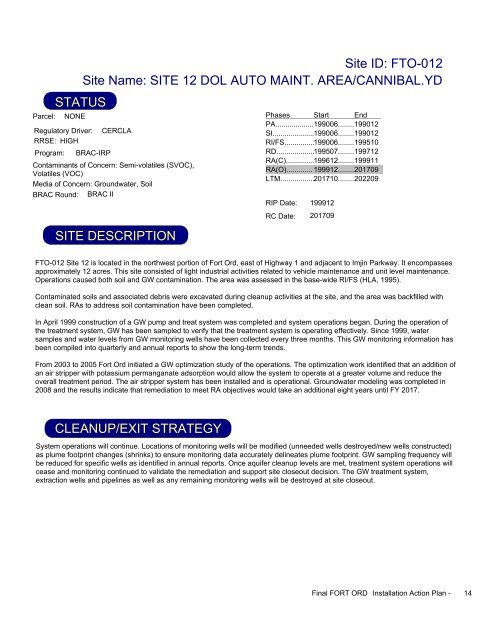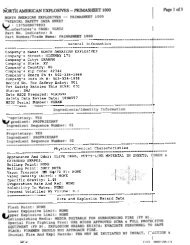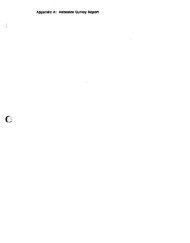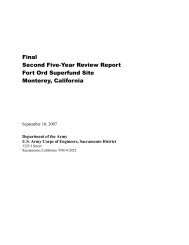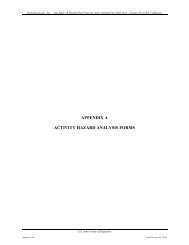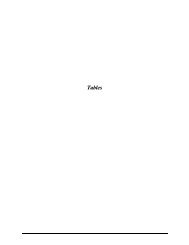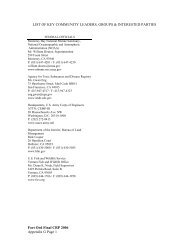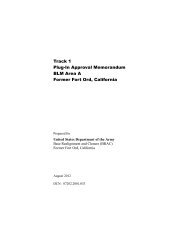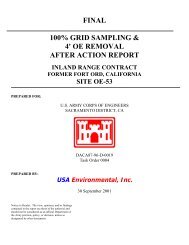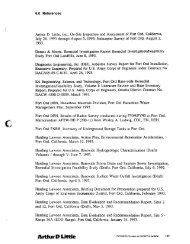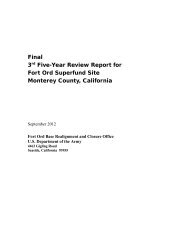FY2009 - Former Fort Ord - Environmental Cleanup
FY2009 - Former Fort Ord - Environmental Cleanup
FY2009 - Former Fort Ord - Environmental Cleanup
You also want an ePaper? Increase the reach of your titles
YUMPU automatically turns print PDFs into web optimized ePapers that Google loves.
STATUS<br />
Parcel: NONE<br />
Site ID: FTO-012<br />
Site Name: SITE 12 DOL AUTO MAINT. AREA/CANNIBAL.YD<br />
Regulatory Driver: CERCLA<br />
RRSE: HIGH<br />
Program: BRAC-IRP<br />
Contaminants of Concern: Semi-volatiles (SVOC),<br />
Volatiles (VOC)<br />
Media of Concern: Groundwater, Soil<br />
BRAC Round: BRAC II<br />
SITE DESCRIPTION<br />
CLEANUP/EXIT STRATEGY<br />
Phases Start End<br />
PA................... 199006........ 199012<br />
SI..................... 199006........ 199012<br />
RI/FS............... 199006........ 199510<br />
RD................... 199507........ 199712<br />
RA(C).............. 199612........ 199911<br />
RA(O).............. 199912........ 201709<br />
LTM................. 201710........ 202209<br />
RIP Date:<br />
199912<br />
RC Date: 201709<br />
FTO-012 Site 12 is located in the northwest portion of <strong>Fort</strong> <strong>Ord</strong>, east of Highway 1 and adjacent to Imjin Parkway. It encompasses<br />
approximately 12 acres. This site consisted of light industrial activities related to vehicle maintenance and unit level maintenance.<br />
Operations caused both soil and GW contamination. The area was assessed in the base-wide RI/FS (HLA, 1995).<br />
Contaminated soils and associated debris were excavated during cleanup activities at the site, and the area was backfilled with<br />
clean soil. RAs to address soil contamination have been completed.<br />
In April 1999 construction of a GW pump and treat system was completed and system operations began. During the operation of<br />
the treatment system, GW has been sampled to verify that the treatment system is operating effectively. Since 1999, water<br />
samples and water levels from GW monitoring wells have been collected every three months. This GW monitoring information has<br />
been compiled into quarterly and annual reports to show the long-term trends.<br />
From 2003 to 2005 <strong>Fort</strong> <strong>Ord</strong> initiated a GW optimization study of the operations. The optimization work identified that an addition of<br />
an air stripper with potassium permanganate adsorption would allow the system to operate at a greater volume and reduce the<br />
overall treatment period. The air stripper system has been installed and is operational. Groundwater modeling was completed in<br />
2008 and the results indicate that remediation to meet RA objectives would take an additional eight years until FY 2017.<br />
System operations will continue. Locations of monitoring wells will be modified (unneeded wells destroyed/new wells constructed)<br />
as plume footprint changes (shrinks) to ensure monitoring data accurately delineates plume footprint. GW sampling frequency will<br />
be reduced for specific wells as identified in annual reports. Once aquifer cleanup levels are met, treatment system operations will<br />
cease and monitoring continued to validate the remediation and support site closeout decision. The GW treatment system,<br />
extraction wells and pipelines as well as any remaining monitoring wells will be destroyed at site closeout.<br />
Final FORT ORD Installation Action Plan - 14


